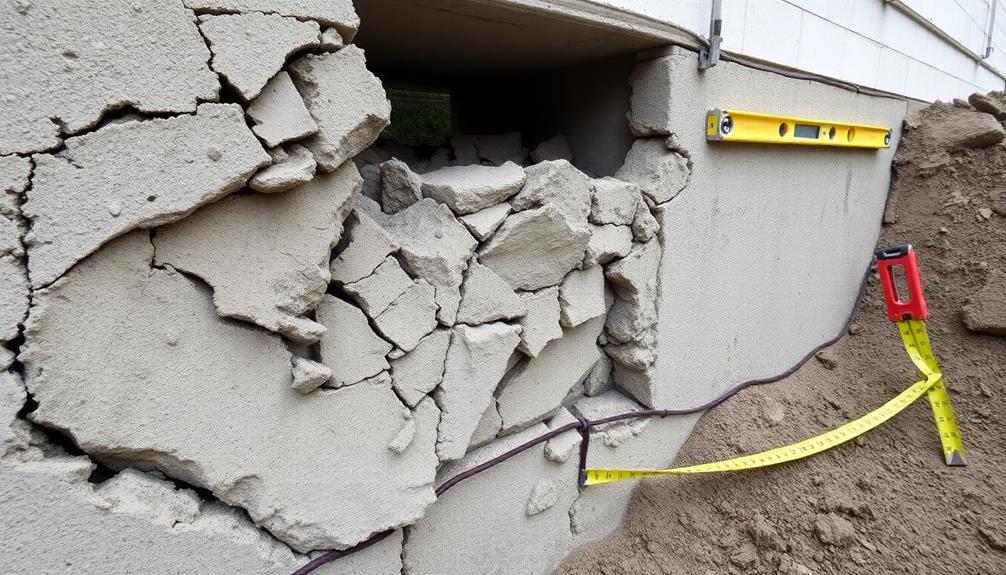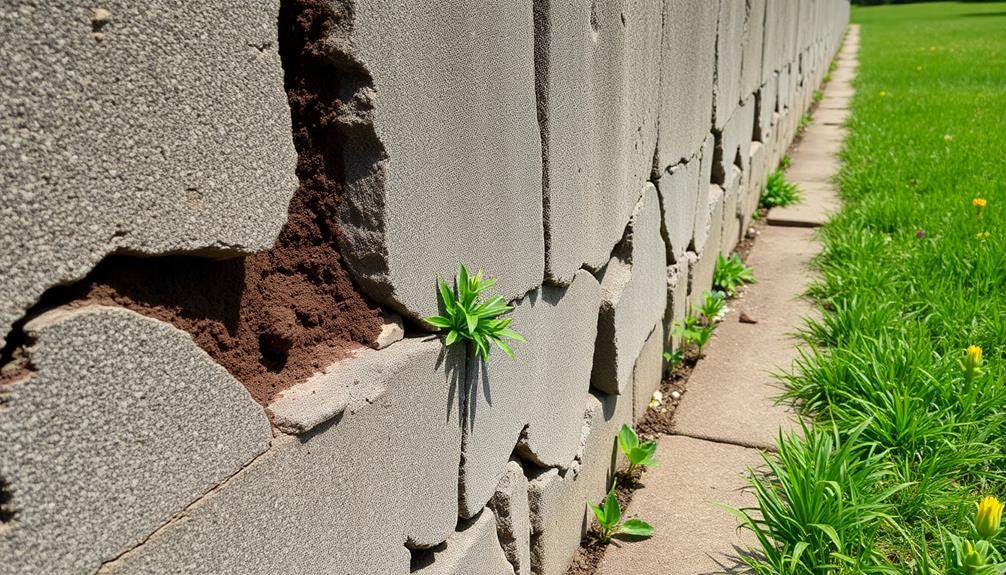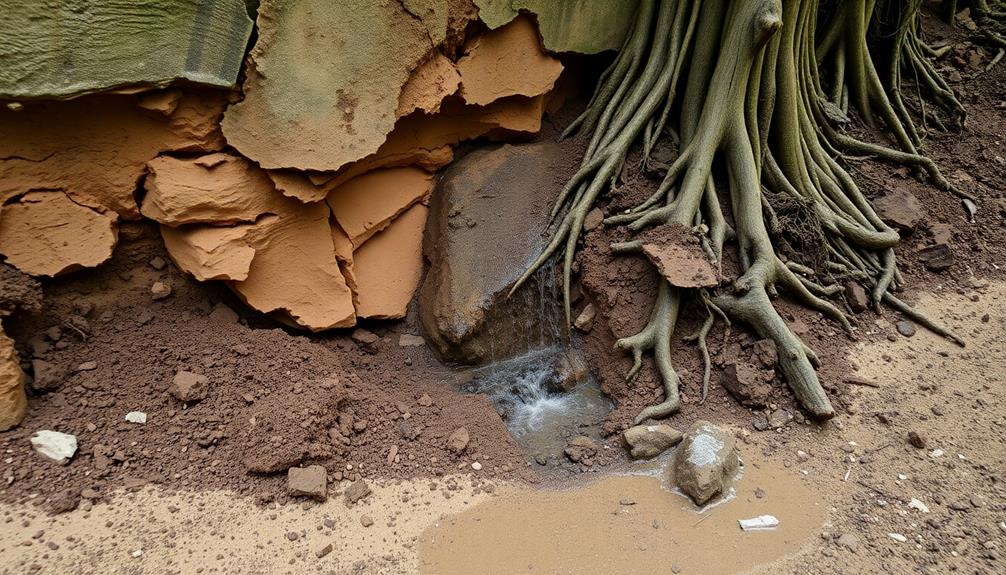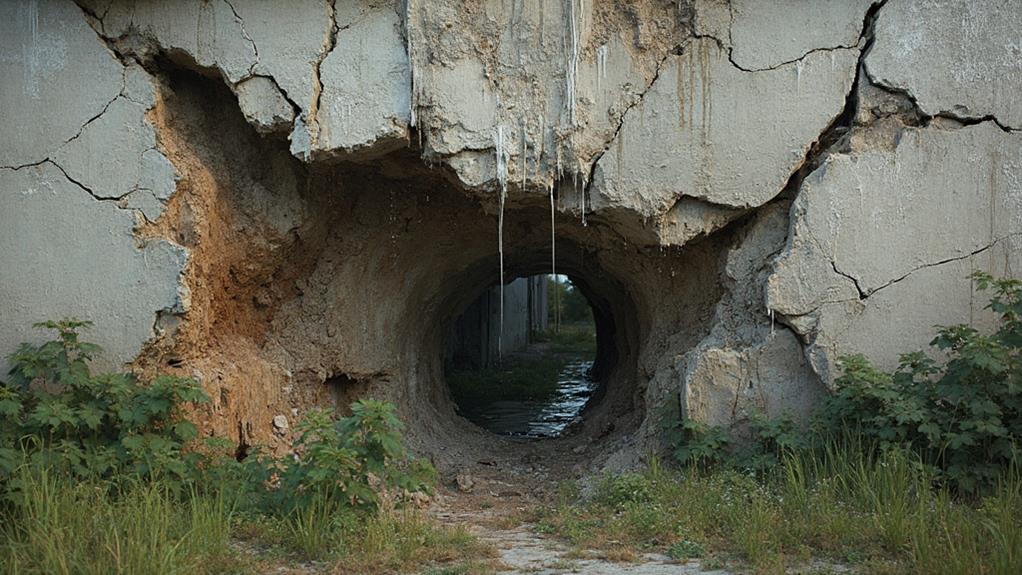Recognizing signs that a retaining wall needs repair is critical for maintaining property safety, value, and structural integrity. Early detection of issues such as exposed roots, soil displacement patterns, and drainage problems can prevent catastrophic failures and costly repairs. Regular visual inspections, soil testing, and load-bearing capacity analyses are essential components of an all-encompassing maintenance strategy. Addressing these indicators promptly helps preserve the wall's functionality, prevents soil erosion, and safeguards surrounding structures. In addition, well-maintained retaining walls contribute to enhanced property aesthetics and increased outdoor living space. Understanding these signs empowers property owners to take proactive measures, ensuring long-term stability and protection of their investments.
Table of Contents
ToggleWalls Contractor Highlights
- Early detection of retaining wall issues prevents costly structural failures and property damage.
- Recognizing repair signs helps maintain soil stability and prevents erosion-related problems.
- Timely repairs preserve property value by ensuring the wall's aesthetic and functional integrity.
- Addressing wall damage promptly ensures continued compliance with local regulations and safety standards.
- Identifying repair needs allows for proactive maintenance, extending the wall's lifespan and effectiveness.
Structural Integrity Assessment Process

The structural integrity assessment process for retaining walls encompasses a thorough evaluation using multiple techniques. During this process, it is essential to evaluate site conditions, taking into account the topography and soil composition to guarantee the wall's longevity and effectiveness.
Visual inspection methods involve scrutinizing the wall for visible defects, such as cracks, bulges, or water seepage, while soil testing procedures analyze the surrounding earth's composition and stability. Load-bearing capacity analysis utilizes advanced engineering calculations and potentially specialized equipment to determine the wall's ability to withstand the forces exerted upon it, verifying its continued functionality and safety.
Visual Inspection Techniques
How can one effectively assess the structural integrity of a retaining wall? Visual inspection techniques serve as a critical first step in identifying potential issues and determining the need for repairs. These techniques involve a systematic examination of the wall's components and surrounding environment, allowing professionals to detect early signs of deterioration or structural compromise.
To conduct a thorough visual inspection, experts typically follow these key steps:
- Assess overall alignment: Check for any visible tilting, bulging, or misalignment along the wall's length and height.
- Examine surface conditions: Look for cracks, spalling, efflorescence, or other signs of material degradation on the wall face.
- Evaluate drainage systems: Inspect weep holes, drainage pipes, and surrounding soil for proper water management.
- Analyze surrounding elements: Consider the impact of nearby trees, slopes, and adjacent structures on the wall's stability.
Soil Testing Methods
While visual inspection techniques provide valuable initial insights, soil testing methods are essential for a thorough assessment of a retaining wall's structural integrity. These methods allow engineers and geotechnical experts to analyze the underlying soil conditions that directly impact the wall's stability and longevity.
Soil testing typically involves a combination of in-situ and laboratory analyses, providing vital data on soil composition, moisture content, compaction, and load-bearing capacity.
Common soil testing procedures include penetration tests, which measure soil resistance and strength, and soil borings, which extract samples for detailed laboratory analysis. These tests reveal critical information about soil stratification, potential water table issues, and the presence of expansive clays or other problematic soil types. Additionally, geophysical methods such as ground-penetrating radar can be employed to detect subsurface anomalies or voids that may compromise the wall's foundation.
The results of these extensive soil tests enable professionals to accurately assess the current state of the retaining wall, predict potential future issues, and develop targeted repair strategies. By understanding the soil conditions, property owners can make informed decisions about necessary interventions, ensuring the long-term stability and safety of their retaining walls.
Load-Bearing Capacity Analysis
A critical component of the structural integrity process for retaining walls is load-bearing capacity analysis. This examination determines the wall's ability to withstand the forces exerted upon it, ensuring its continued stability and safety. Engineers employ sophisticated techniques to assess the wall's current condition and predict its future performance under various load scenarios.
The load-bearing capacity analysis typically involves the following steps:
- Structural evaluation: assessing the wall's construction, materials, and existing damage
- Soil analysis: Determining the properties of the retained soil and foundation
- Load calculation: Quantifying the forces acting on the wall, including soil pressure, surcharge loads, and hydrostatic pressure
- Modeling and simulation: Using computer-aided design to predict the wall's behavior under different conditions
Benefits

Repairing a retaining wall offers numerous advantages that extend beyond structural integrity. The process can markedly enhance property value by improving the overall landscape aesthetics and creating a more visually appealing outdoor environment.
For instance, incorporating eco-friendly materials in the repair can further increase sustainability and reduce environmental impact, which aligns with sustainable practices. Additionally, a well-maintained retaining wall plays a pivotal role in preventing soil erosion, while simultaneously increasing usable outdoor living space, thereby maximizing the functionality and enjoyment of one's property.
Enhanced Property Value
One significant benefit of addressing retaining wall repair signs promptly is the enhancement of property value. A well-maintained retaining wall not only guarantees the structural integrity of your landscape but also contributes to the overall aesthetics and functionality of your property. By addressing repair needs in a timely manner, homeowners can prevent further deterioration and potentially costly damage, while simultaneously increasing their property's market value.
Consider the following ways in which repairing your retaining wall can enhance your property value:
- Improved curb appeal, attracting potential buyers and creating a positive first impression
- Enhanced landscape functionality, preventing soil erosion and maintaining proper drainage
- Increased usable outdoor space, potentially expanding living areas or garden zones
- Demonstration of proper home maintenance, signaling to prospective buyers that the property has been well-cared for
Improved Landscape Aesthetics
Beyond the financial benefits of increased property value, addressing retaining wall repair signs can additionally enhance the aesthetic appeal of your landscape. A well-maintained retaining wall serves as a visually striking element, complementing your outdoor space and creating a cohesive design that elevates the overall appearance of your property. By promptly addressing issues such as cracks, bulges, or leaning, you prevent unsightly deterioration that can detract from your garden's beauty.
Repairing a damaged retaining wall allows for the integration of modern design elements and materials that can transform your outdoor living area. You may choose to incorporate natural stone veneers, textured concrete, or even integrate decorative plantings into the wall's structure. These enhancements not only improve the wall's functionality but also create a focal point that draws the eye and adds depth to your landscape. Moreover, a restored retaining wall provides a clean backdrop for ornamental plants, allowing you to showcase your horticultural efforts more effectively. The renewed structure also contributes to a sense of order and intentionality in your outdoor space, reflecting your commitment to maintaining a polished and inviting environment for both residents and visitors alike.
Prevention of Soil Erosion
A critical benefit of addressing retaining wall repair signs is the prevention of soil erosion. When a retaining wall begins to fail, it compromises its primary function of holding back soil and preventing it from shifting or eroding. By promptly addressing repair signs, property owners can maintain the wall's structural integrity and continue to protect their landscape from erosion-related issues.
Preventing soil erosion through timely retaining wall repairs offers several advantages:
- Preservation of property value by maintaining stable ground conditions
- Protection of surrounding structures and vegetation from soil displacement
- Reduction of potential water drainage problems and foundation issues
- Compliance with local regulations regarding soil stability and erosion control
Increased Outdoor Living Space
Through proper maintenance and repair of retaining walls, homeowners can effectively increase their usable outdoor living space. A well-maintained retaining wall not only provides structural support but also creates additional flat, stable areas on sloped properties. These newly leveled spaces can be transformed into functional outdoor rooms, expanding the home's livable square footage and enhancing its overall value.
By addressing signs of retaining wall damage promptly, property owners safeguard their investment while simultaneously opening up the potential for creative landscape design. The reclaimed space can accommodate a variety of amenities, such as patios, gardens, or outdoor kitchens, tailored to the homeowner's lifestyle preferences. Additionally, a properly functioning retaining wall confirms the longevity of these outdoor improvements by mitigating soil erosion and water drainage issues that could otherwise compromise the integrity of the newly created living areas.
Homeowners who prioritize retaining wall maintenance often find themselves part of a community of conscientious property owners who value both aesthetics and functionality. This approach not only enhances individual properties but contributes to the overall appeal and cohesion of the neighborhood, fostering a sense of pride and belonging among residents.
Soil Erosion Behind Wall

Soil erosion behind a retaining wall can manifest through several key indicators that property owners should vigilantly monitor. Exposed roots or gaps near the wall's base, unusual soil displacement patterns, and observable drainage issues all serve as critical warning signs of potential erosion problems. The following table outlines these indicators, their potential causes, and recommended actions to address each issue:
| Indicator | Potential Cause | Recommended Action |
|---|---|---|
| Exposed Roots or Gaps | Soil Settlement | Backfill and Compact |
| Soil Displacement Patterns | Water Pressure | Improve Drainage System |
| Drainage Issues | Clogged Weep Holes | Clean or Replace Drainage |
| Tilting or Bulging Wall | Excessive Pressure | Consult Structural Engineer |
Exposed Roots or Gaps
Exposed roots or gaps behind your retaining wall are clear indicators of soil erosion, a serious issue that can compromise the wall's integrity. These symptoms often manifest gradually, making regular inspections pivotal for homeowners and property managers alike.
When soil erodes, it can create voids that destabilize the entire structure, potentially leading to costly repairs or complete wall failure.
To address exposed roots or gaps effectively, consider the following steps:
- Conduct a thorough assessment of the wall's condition, noting the extent of erosion and any visible damage
- Consult with a professional engineer or landscaper to determine the underlying cause of the erosion
- Implement proper drainage solutions to redirect water away from the wall and prevent further soil loss
- Backfill any gaps with appropriate soil and compact it to guarantee stability
Soil Displacement Patterns
Identifying soil displacement patterns behind a retaining wall is a key aspect of evaluating its structural health. As homeowners and property managers, it is paramount to recognize the signs of soil erosion or movement that may indicate potential wall failure.
These patterns often manifest as depressions or mounds in the soil behind the wall, uneven settlement of the ground surface, or the appearance of soil washout at the base of the structure.
One should carefully observe the area surrounding the retaining wall for any changes in soil elevation or consistency. The presence of cracks in the soil, particularly those running parallel to the wall, may signify soil movement and pressure buildup. Additionally, water pooling or excessive moisture retention behind the wall can lead to soil saturation and subsequent displacement.
It bears emphasis that even subtle changes in soil patterns can indicate underlying issues that may compromise the wall's integrity over time. Regular inspections and prompt attention to these displacement patterns are essential for maintaining the longevity and stability of your retaining wall, ensuring the safety and value of your property.
Drainage Issues Observed
Three vital drainage issues often observed behind retaining walls can lead to considerable soil erosion and potential structural failure. These problems, if left unaddressed, can compromise the integrity of your retaining wall and the surrounding landscape. As responsible property owners, it's imperative to recognize and promptly address these issues to maintain the stability and longevity of your retaining structure.
The most common drainage problems include:
- Inadequate or clogged weep holes, preventing proper water evacuation
- Improperly installed or damaged drainage pipes behind the wall
- Poor grading or compaction of backfill material
- Absence of a proper drainage layer or filter fabric
These issues can result in hydrostatic pressure buildup, soil saturation, and erosion, ultimately leading to wall displacement or collapse. Regular inspections and maintenance are essential to identify and rectify these problems before they escalate. By implementing proper drainage solutions, such as installing or cleaning weep holes, repairing damaged pipes, and improving backfill composition, you can substantially extend the lifespan of your retaining wall and protect your property investment.
Walls Contractor FAQ
How Long Does a Typical Retaining Wall Repair Process Take?
The duration of a typical retaining wall repair process varies depending on the extent of damage and wall size. Generally, minor repairs can take a few days, while more extensive renovations may require several weeks to complete properly.
Can I Repair My Retaining Wall Myself or Should I Hire Professionals?
While minor repairs can be tackled by DIY enthusiasts, it's generally advisable to hire professionals for retaining wall repairs. They possess the expertise, tools, and knowledge to guarantee structural integrity and safety, giving you peace of mind.
What Is the Average Cost of Repairing a Retaining Wall?
The average cost of repairing a retaining wall varies widely, typically ranging from $800 to $3,000. Factors influencing the price include wall size, materials, extent of damage, and location. For a precise estimate, consult local professionals in your community.
Are There Any Eco-Friendly Materials for Retaining Wall Repairs?
Yes, eco-friendly materials for retaining wall repairs are available. Options include recycled concrete, reclaimed wood, and gabion baskets filled with locally-sourced stones. These sustainable choices not only benefit the environment but also enhance the aesthetics of your outdoor space.
How Often Should I Schedule Inspections for My Retaining Wall?
Regular inspections of your retaining wall are pivotal for maintaining its integrity. Schedule professional assessments annually, or bi-annually for older structures. After severe weather events, it's wise to conduct additional checks to verify your wall's continued stability and safety.







